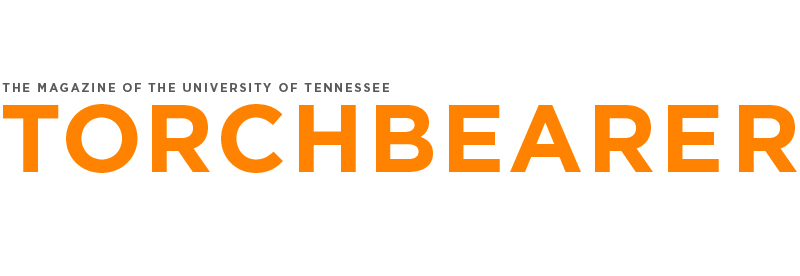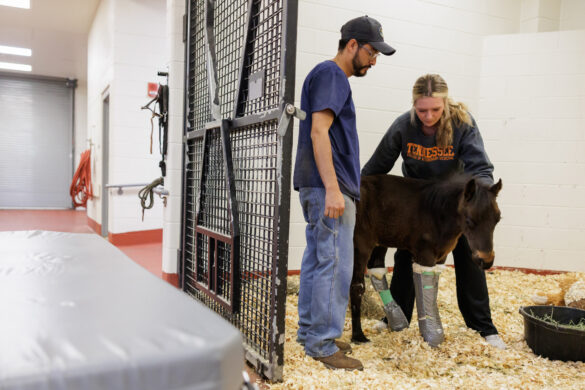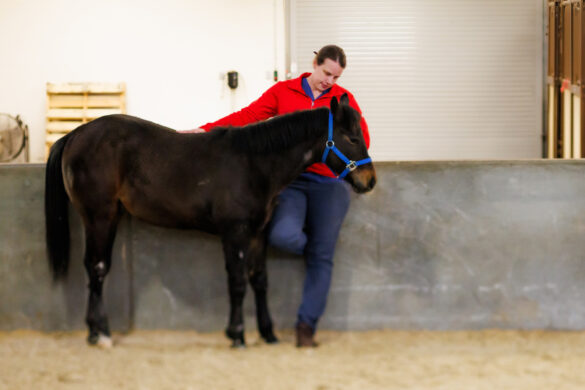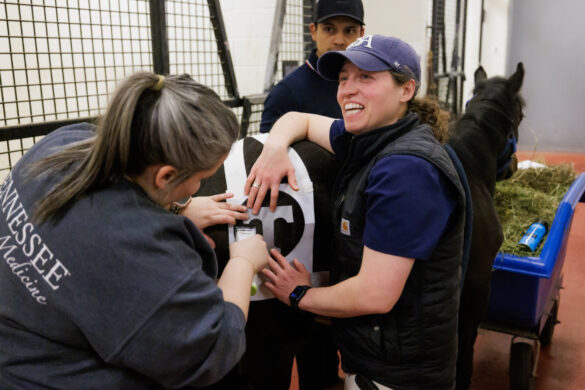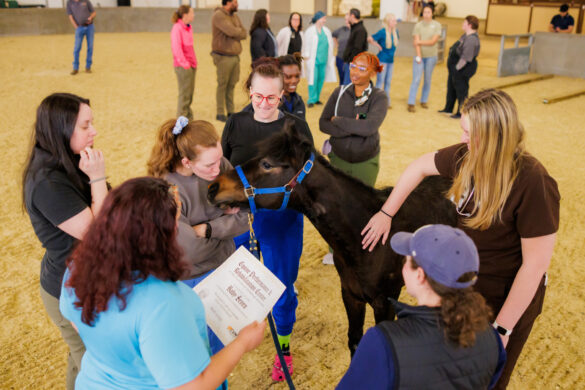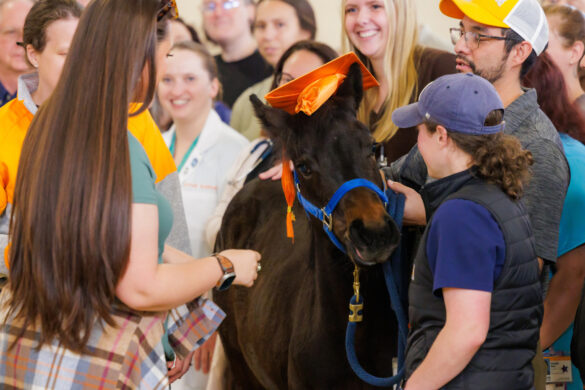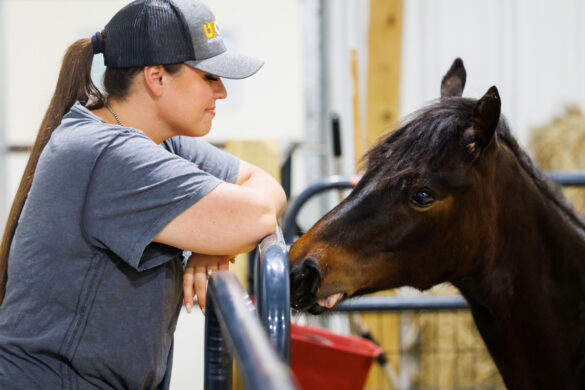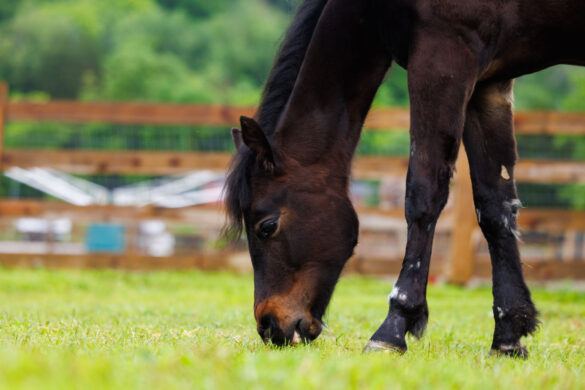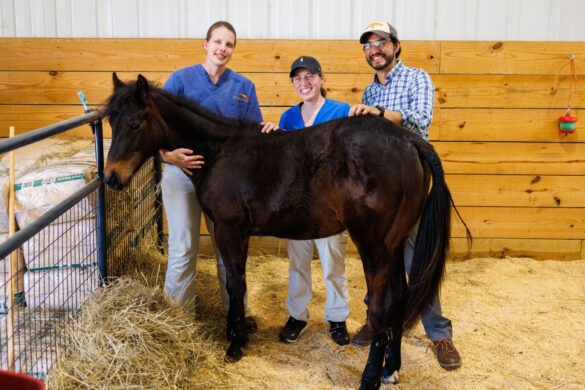There was nothing typical about the life of the horse called Seven.
He was born too soon, surviving against the odds, and left the world too soon. But the legacy of learning and support he leaves behind at the College of Veterinary Medicine will live on for years to come.
 Seven was born two months early at just 286 days gestation. His heart, lungs, and brain were developed enough to sustain him, but the bones in his knees and hocks hadn’t fully hardened.
Seven was born two months early at just 286 days gestation. His heart, lungs, and brain were developed enough to sustain him, but the bones in his knees and hocks hadn’t fully hardened.
The fragile foal spent his first three months in casts, being encouraged to lie down to protect his developing bones. Seven’s owner, Katie Van Slyke, documented his progress on social media, where fans around the world began following his story and learning about the power of veterinary rehabilitation.
Seven came to UTCVM’s Equine Performance and Rehabilitation Center at four and a half months old. Clinical Assistant Professor of Equine Rehabilitation Tena Ursini says she immediately realized that UTCVM—one of only 33 veterinary colleges nationwide—was the right place to handle such a complex case.
“Physical rehabilitation is very labor intensive and takes a lot of manpower, time, and dedication, and not every facility is set up for that,” she says. “That’s why facilities like ours exist.”
From the very beginning, Seven’s care team knew they would have to think outside the box to give him a chance to live. But they could also tell that he was a fighter and wanted to live.
“He wants so bad to be a normal horse,” said Van Slyke in a September 2024 video. “And we are trying our best to give him the chance to do that.”
Collaborative Care
One major challenge was finding a way to give Seven’s joints adequate support while allowing him to get up and down safely and participate in strength-building activities like the underwater treadmill. With those goals in mind, Ursini sought insight from Clinical Associate Professor of Small Animal Clinical Sciences Marti Drum to create custom orthotics for Seven.
Ursini had used similar types of orthotics in adult horses but had never made a custom one for a smaller animal. “That was definitely a learning experience for me,” she says. “Orthotics need to fit perfectly, just like a prosthetic in a person, without any rubbing or tightness, but we also had
to restrict the joints’ motion in certain planes and account for some degree of growth, so it was a lot of tweaking.”
A recurring theme throughout Seven’s time at UTCVM was how to deal with his tricky combination of joint laxity, joint contracture, angular limb deformities, and incomplete ossification—conditions UTCVM had treated in isolation in plenty of older foals and horses, but not in conglomeration in one very young animal. Teamwork proved to be the key to finding creative solutions.
“What we have here is a truly multidisciplinary and collaborative team,” Ursini says. “I don’t think anybody else could have done a better job for him.
Valuable contributions came from the whole hospital, from day crew to night crew, podiatry, anesthesia, medicine, and surgery. Seven pretty much touched every specialty here at UT, and they stayed consistently invested in his case.”
Over time, Seven’s care team gently guided him toward having more function. “He wanted to do things and explore, and that was to his benefit,” Ursini says. “Some other animals don’t necessarily have that drive. But if the animal’s all in and the owner’s all in, there’s really no reason why we as the veterinary team can’t be all in, with realistic expectations. That’s where people saw his personality, too,” she adds.
Seven became known to his caretakers and social media followers for his cheerful whinny, sticking out his tongue, and chasing the alfalfa cart down the halls of the Equine Performance and Rehabilitation Center. Veterinary Technician Zoe Stoloff built a particularly strong relationship with the feisty foal.
“Dr. Ursini told me not to get too attached to him,” Stoloff says. “But when you spend nine hours out of the day staring at him, lifting him up, turning him, feeding him—it kinda happens.”
Ursini says after floating Seven for the first time in the underwater treadmill, she was drying him off and thought, How the hell do we not get attached?
Stoloff says Seven was the best patient and trusted the team to do what they needed to do, whether the farrier was putting on new shoes or caregivers were changing bandages on a gurney.

Some faculty and staff from the College of Veterinary Medicine with Seven in March 2025 on the day he returned home to Running Springs Farm.
A Legacy of Learning
Seven’s time at UTCVM gave veterinary students an opportunity to learn from and care for an unusually complex case. For nine months, UTCVM students were assigned to Seven in two-week rotations, learning hands-on from staff who’d been working with him over time.
“There’s something to be said about not just reading the textbook, especially in a referral hospital where we get the worst cases,” Ursini says. “Seven’s case was a nice way to highlight what rehab can do.”
Throughout Seven’s stay at UT, Van Slyke used her social media to give Ursini a platform for educating other horse owners and equine veterinarians. The Vol Vet Review is a weekly video series that covers a variety of problems common in animals, including some that Seven himself faced. The series has extended to cover other species of animals with information from various UTCVM faculty.
Ashton Bazzell, a student who worked with Seven on a clinical rotation, was tasked with reviewing his history and progress. She was responsible for his daily physicals, paperwork, rounds, treatments, medication administration, and overall just keeping an extra set of eyes on him.
“It was a good learning experience for me because it’s not a normal case,” Bazzell says. “But I could see all of his imaging [X-rays, MRIs] and how it showed him as a full picture and everything he had been through in the months leading up to it. It was a wonderful experience.”
“Seven solidified that there never really is a zero percent chance,” says Ursini. “He did show the world the power of rehab. You can take a limp noodle to a dude that’s going to chase the hay cart.”
In March, after nine months at UT, Seven went home to Van Slyke’s farm.
“We all had the same goal—get him home so he can just live a happy and comfortable-as-he-can life,” Stoloff says. “Katie would post video of him grazing, and that was the whole point.”
For five months, Van Slyke continued to update Seven’s followers on social media with videos and updates on his health. Unfortunately, in August he began experiencing complications exacerbated by colic and extreme summer heat, and the difficult decision was made to humanely euthanize him.
Seven passed away on August 11 at 18 months old.
Inspired by the care Seven received, Van Slyke created the Baby Seven Equine Medicine Scholarship that supports seven third- and fourth-year equine vet med students with $7,000 each.
“While Seven’s life was short, he impacted so many and for so many different reasons,” Van Slyke posted on her social media. “It gives me such peace to know that future veterinarians will have benefited from his life, and his legacy will live on through their knowledge and practice.”
When Van Slyke announced Seven’s passing, she shared a link for the scholarship. Just a few weeks later, the fund had received more than $218,000 in donations from all 50 states and 20 countries.
Van Slyke said in a video update that $133,000 more has been raised through the sale of merchandise featuring Seven. She also recently created an endowment for the scholarship. Gifts for the Baby Seven scholarship will now be directed to the endowment, with the goal of supporting seven students each with a $7,000 scholarship in perpetuity.
Following his death, UTCVM posted a tribute on its social media channels. “Baby Seven’s life was a testament to hope, compassion, and the tireless dedication of everyone who cared for him. His journey was remarkable, not only for his resilience and spirit but for the profound impact he had on our faculty, staff, and students.”
Seven’s Journey in Photos
SUPPORTING LARGE ANIMALS
Since its grand opening in 2013, Equine Services at the UT College of Veterinary Medicine has served thousands of horses and their owners, including Seven. The expansion of its facilities is thanks in no small part to Charles (’65) and Julie Wharton, whose dedicated support to the college and many other areas of the university has sparked transformational growth and medical breakthrough.
The Equine Intensive Care Unit is named in their honor, and the entire Large Animal Hospital was renamed the Charles and Julie Wharton Large Animal Hospital in 2022 in recognition of their extraordinary support to the college, which dates from the 1980s. The hospital comprises Equine Services, Farm Animal Services, and the Equine Performance and Rehabilitation Center, which serves many farm and other large animals, from cattle to pigs.
Even more than 10 years after its opening, the EPRC stands out as a unique feature of the college, offering unparalleled medical care to horses in Tennessee and surrounding states and training tomorrow’s veterinarians.
Help equine veterinarian students by giving to the Baby Seven Equine Medicine Scholarship Fund
